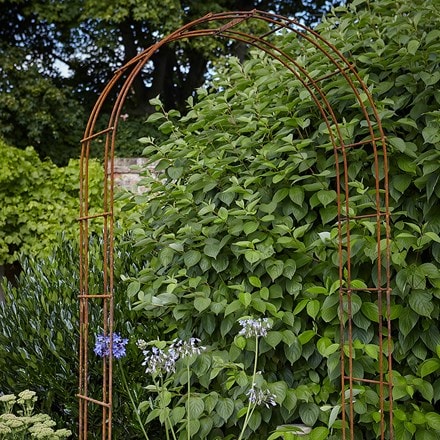Passiflora 'Cool Tropics Snowstar'
passion fruit
- 2 litre pot
- £29.99
- available to order from spring
Delivery options
- Standard £5.99
- Position: full sun
- Soil: moderately fertile, moist, well-drained or large pots filled with loam-based compost
- Rate of growth: fast
- Flowering period: June to August
- Hardiness: borderline hardy (may need winter protection)
A ‘hardier-than-most’ passionflower with breathtaking blooms, Passiflora 'Cool Tropics Snowstar' showcases vigorous, semi-evergreen growth producing a dense canopy of glossy, tri-lobed leaves, perfect for creating an exotic screen or a dramatic feature against a sunny, sheltered wall.
Large, white flowers up to 9cm (3.5in) across steal the show with intricate, wavy filaments surrounding a prominent central stalk, followed by curious, inedible egg-sized yellow fruits.
This versatile vine grows well in coastal or southerly regions of the UK but must be protected from severe or prolonged frosts, but is an excellent choice for bringing tropical flair to UK gardens.
Large, white flowers up to 9cm (3.5in) across steal the show with intricate, wavy filaments surrounding a prominent central stalk, followed by curious, inedible egg-sized yellow fruits.
This versatile vine grows well in coastal or southerly regions of the UK but must be protected from severe or prolonged frosts, but is an excellent choice for bringing tropical flair to UK gardens.
Passionflowers thrive in moist, well-drained soil enriched with plenty of well-rotted manure or garden compost before planting. Choose a sunny, sheltered spot protected from cold winds or pot up in a greenhouse or conservatory for earlier growth and better fruit ripening.
Provide sturdy support, such as trellis or horizontal wires, for the twining stems to climb. Water freely during the growing season and reduce slightly in winter. For container growing, use large pots to account for rapid root growth, and ensure plants are moved to a frost-free location in winter.
Feed regularly throughout the growing season and mulch in autumn with well-rotted manure or compost. In late autumn, cut back the top growth to around 10cm (4in) and apply light winter protection, such as a thick mulch around the base (avoiding the main stem) and wrapping the plant with a double layer of horticultural fleece if heavy frost is forecast.
Passionflowers may die back in winter but will re-emerge in late spring in milder regions of the UK. Prune in spring to remove dead or overcrowded stems, and once established, trim flowered shoots after blooming to encourage strong growth.
Provide sturdy support, such as trellis or horizontal wires, for the twining stems to climb. Water freely during the growing season and reduce slightly in winter. For container growing, use large pots to account for rapid root growth, and ensure plants are moved to a frost-free location in winter.
Feed regularly throughout the growing season and mulch in autumn with well-rotted manure or compost. In late autumn, cut back the top growth to around 10cm (4in) and apply light winter protection, such as a thick mulch around the base (avoiding the main stem) and wrapping the plant with a double layer of horticultural fleece if heavy frost is forecast.
Passionflowers may die back in winter but will re-emerge in late spring in milder regions of the UK. Prune in spring to remove dead or overcrowded stems, and once established, trim flowered shoots after blooming to encourage strong growth.
To avoid dry conditions, and to ensure good soil contact around the rootball, we advise planting climbers at least 30cm (12in), and preferably 45-60cm (18-24in) away from the base of a wall or fence. An even larger distance should be maintained when planting climbers beside an existing tree or shrub.
Goes well with
Rustique garden arch - rust
W120cm × D40cm × H230cm
£149.99
In stock (shipped within 2-3 working days)





